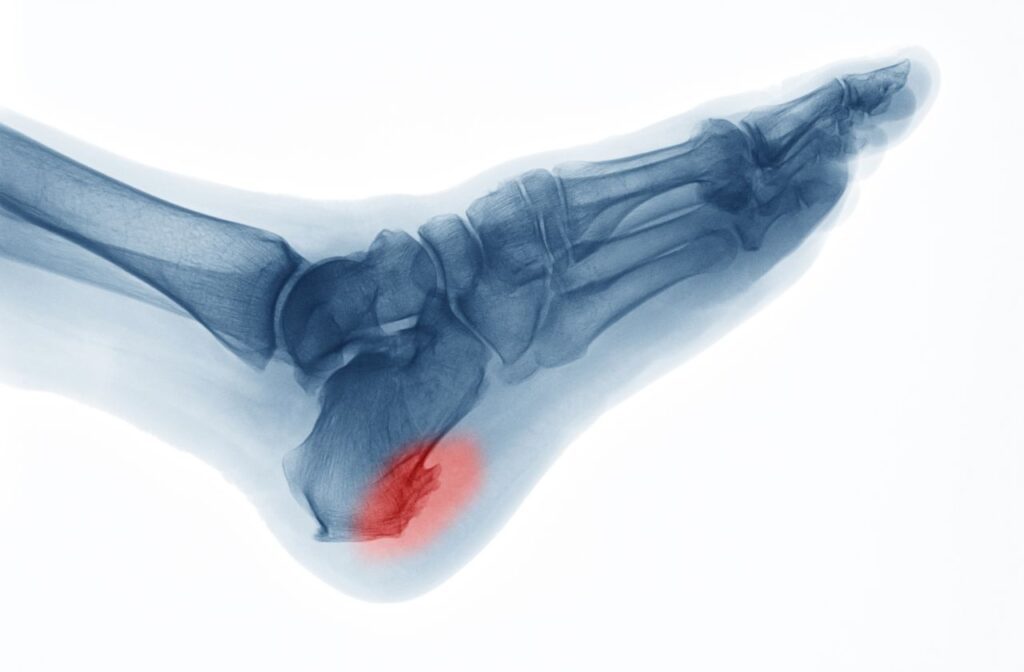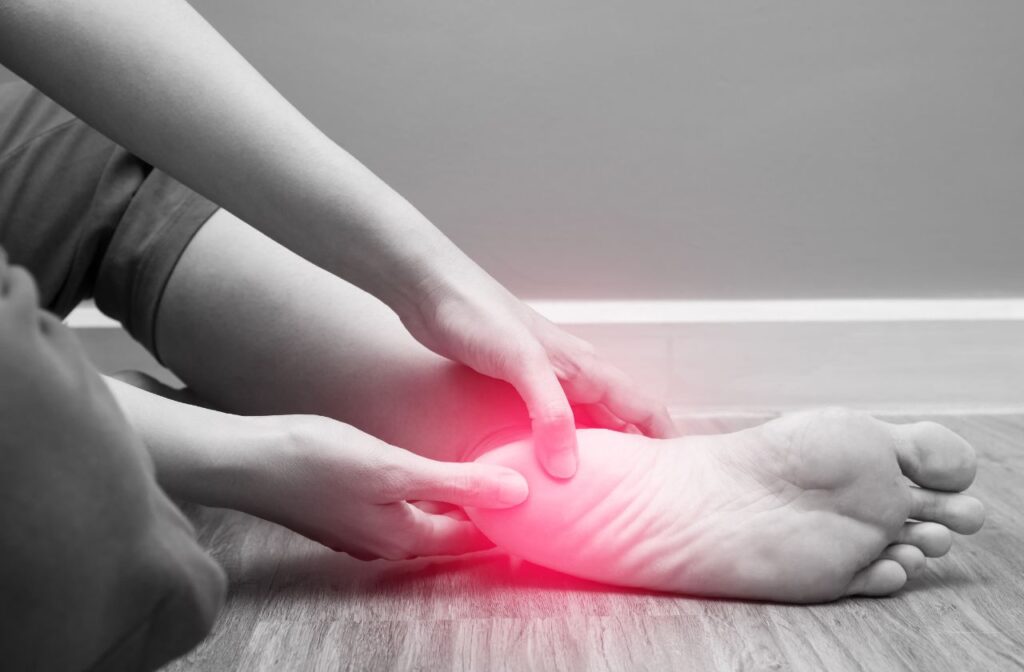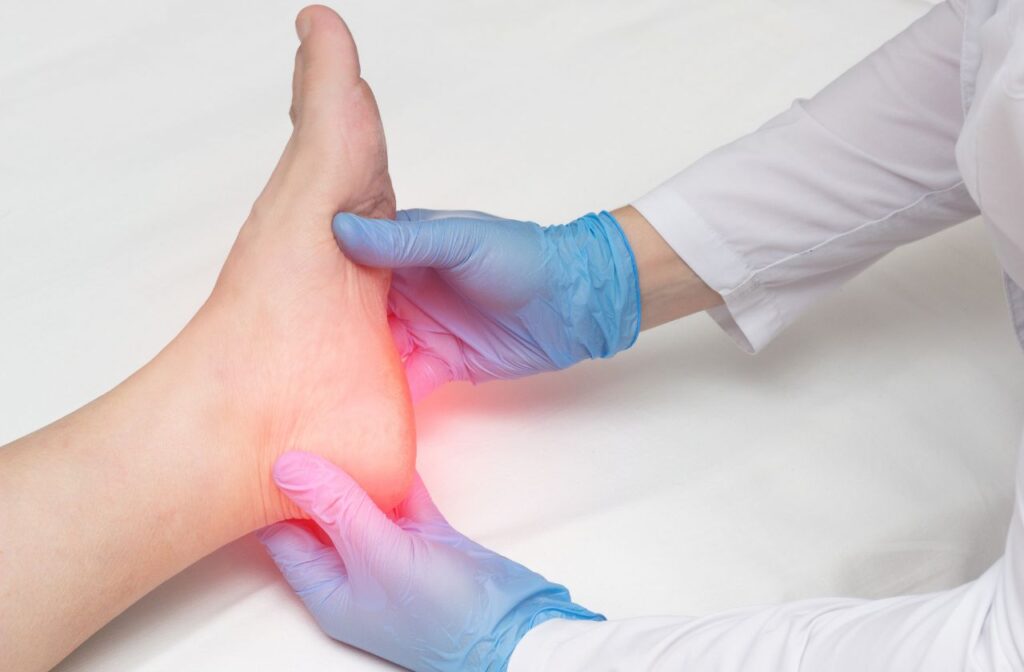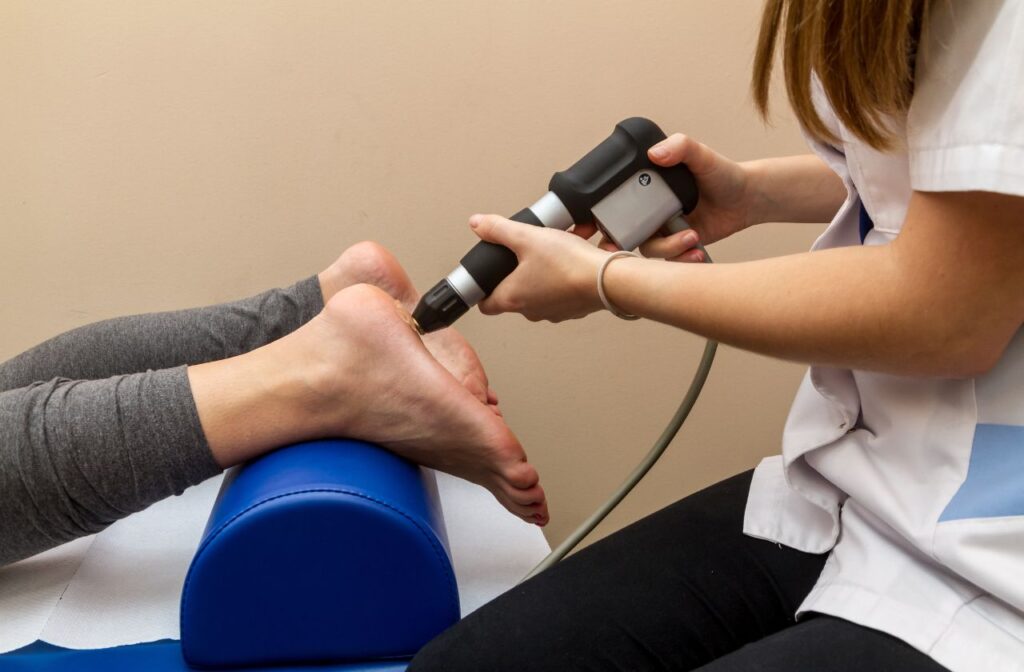Most of us have heard of the term ‘heel spur’; but what actually are heel spurs, and what does having one mean for you? We’ll explore these questions in this blog by running through what a heel spur is, what causes a heel spur, and what symptoms they may cause. Of course, we’ll also cover treatment options and when to see a podiatrist for a heel spur.

What is a heel spur?
A heel spur refers to a bony protrusion from the base of your heel bone (calcaneus) which extends into the arch of your foot, towards your toes. This happens at the point of the heel where your plantar fascia attaches and originates. The plantar fascia is a fibrous band which supports the main arch of your foot by resisting excess flattening and acting as a kind of spring to keep us moving forward.
Excess force happening at the attachment point of the plantar fascia can cause a gradual trauma to that part of the heel bone, which the body responds to by producing more bone in an attempt to heal. This excess bony calcification tissue growing resembles a ‘tuft’ or ‘spike’ of bone. The medical term for this ‘spur’ of bone is an ‘osteophyte.’ Around 12% of the general population have heel spurs, so they are extremely common!
Osteophytes or ‘spurs’ can actually occur anywhere in the body where there is a similar pulling force on a bone from a strong tendon. Another common spot is at the back of the heel where the achilles tendon attaches. This area is also prone to pulling up small ‘spurs’ from the heel bone into the achilles tendon.

What does a heel spur feel like?
You may think based on the location under the foot and the appearance of a heel spur that it would cause pain, however this is rarely the case. Spurs are present in 12% of the population, and most people have no symptoms and are unlikely to even know they have a heel spur.
If you do have heel pain, even if there is a heel spur present, most of the time there will be an alternative explanation for the pain occurring in the area such as an inflammation or damage to the plantar fascia, also known as plantar fasciitis. Plantar fasciitis is a super common cause of heel pain that most people have heard of. It occurs due to an excessive amount of strain going through the plantar fascia band such as in the case of ‘flat feet’ and overuse.
If this sounds familiar, it’s because it is; the causes of plantar fasciitis are the same as the causes of a heel spur. The conditions are so similar in fact that they are often used interchangeably. Even though they are not the same thing, lots of people will feel heel pain and think “I must have a heel spur” or be told that they have ‘heel spurs’. Not only is this way of describing heel pain confusing and incorrect, it also implies that heel spurs are always present when there is heel pain, which is certainly not the case. In fact, in people with heel pain and plantar fasciitis, the presence of heel spurs is not significantly higher.
How are heel spurs diagnosed?
The only way to know if a heel spur is actually present is to get a foot x-ray done. However; if a heel spur does show up on the imaging, how do we know if its presence is important, or if it is simply an incidental finding?
The good news is that we don’t need to know in order to treat heel pain, as both potential causes (heel spurs and plantar fasciitis) require the same treatment. Having a heel spur does not mean you need surgery or for the spur to be ‘broken up’ using shockwave or laser. Instead we simply address the causative factors and provide long-term symptom relief with evidence-based treatment.
What are the symptoms of a heel spur?
The symptoms of a heel spur are actually hard to describe. This is because a heel spur rarely occurs in isolation as an explanation for pain. Heel spur symptoms will therefore present very similarly to the symptoms of plantar fasciitis:
- Pain under the heel particularly in the spot right at the start of the arch of your foot
- A sharp pain first thing in the morning (or after sitting down for a long time) when you take your first steps
- Worsened pain when walking barefoot or in flat shoes
- A burning feeling under the feet
- Pain which gradually worsens throughout the day
- Improves with rest and time off your feet

What causes heel spurs?
Heel spurs appear to occur in around 12% of the population and usually are not symptomatic. They seem to happen when there is extra force going through the plantar fascia (band along the arch of your foot) which creates a pulling force on the heel bone.
Risk factors for this problem include:
- Having pronated (flat or rolled-in) feet
- Having a family history of plantar fasciitis
- Osteoarthritis
- Inflammatory disorders
- Having a rigid or high-arched foot
- Wearing flat or unsupportive shoes
- Walking barefoot
- Over-training
- Obesity
- Standing on hard floors
- Lots of walking throughout the day consistently (e.g. at work)

Heel spur treatment
There are many ways to treat the heel pain associated with heel spurs and plantar fasciitis. For podiatrists, treating heel pain is their bread and butter. Seeing a podiatrist is a great place to start for a range of treatments:
- Custom foot orthotics
- Foot and ankle strapping
- Footwear changes
- Reduce load and time on your feet
- Soft-tissue massage
- Stretching and strengthening of specific muscles
- Foot mobilisation
- Anti-inflammatory medication or gels
- Icing the area
- Stretching the arch of your foot by rolling over a golf ball or frozen water bottle
- Corticosteroid injection
- Shockwave therapy
- Laser therapy
What to do if you have heel spurs?
If you have heel pain there is no reason to delay treatment. Heel pain is not normal and you do not have to put up with it! If you are suffering from heel pain your first step should be to book an appointment with one of our friendly and knowledgeable podiatrists.
Our podiatrists will investigate potential causes for heel pain, presence of heel spurs, and provide appropriate targeted treatment to get you back on your feet. Come and see us today by calling 1300 76 33 66 or booking online.
